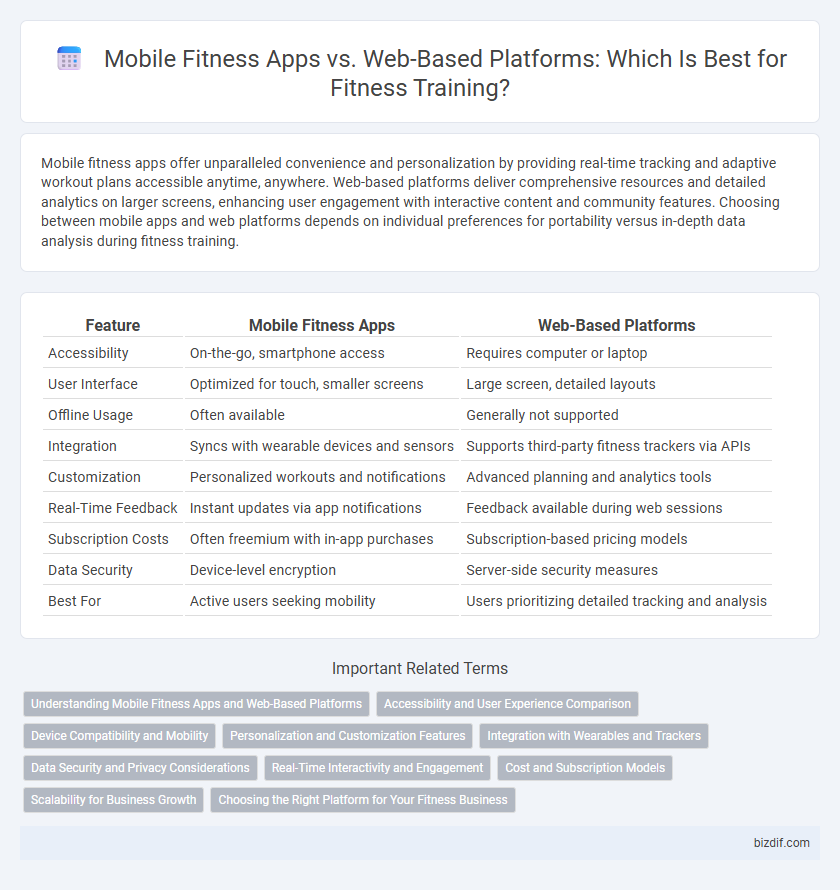Mobile fitness apps offer unparalleled convenience and personalization by providing real-time tracking and adaptive workout plans accessible anytime, anywhere. Web-based platforms deliver comprehensive resources and detailed analytics on larger screens, enhancing user engagement with interactive content and community features. Choosing between mobile apps and web platforms depends on individual preferences for portability versus in-depth data analysis during fitness training.
Table of Comparison
| Feature | Mobile Fitness Apps | Web-Based Platforms |
|---|---|---|
| Accessibility | On-the-go, smartphone access | Requires computer or laptop |
| User Interface | Optimized for touch, smaller screens | Large screen, detailed layouts |
| Offline Usage | Often available | Generally not supported |
| Integration | Syncs with wearable devices and sensors | Supports third-party fitness trackers via APIs |
| Customization | Personalized workouts and notifications | Advanced planning and analytics tools |
| Real-Time Feedback | Instant updates via app notifications | Feedback available during web sessions |
| Subscription Costs | Often freemium with in-app purchases | Subscription-based pricing models |
| Data Security | Device-level encryption | Server-side security measures |
| Best For | Active users seeking mobility | Users prioritizing detailed tracking and analysis |
Understanding Mobile Fitness Apps and Web-Based Platforms
Mobile fitness apps provide users with on-the-go access to personalized workout routines, real-time tracking, and seamless integration with wearable devices, enhancing convenience and motivation. Web-based platforms offer comprehensive fitness management with detailed analytics, large-screen interfaces, and community features that support long-term planning and social interaction. Both solutions harness advanced algorithms to deliver customized training experiences, but mobile apps excel in portability while web platforms provide extensive resources and in-depth progress monitoring.
Accessibility and User Experience Comparison
Mobile fitness apps offer unparalleled accessibility, allowing users to engage in workouts anytime and anywhere through smartphones, leveraging features like GPS and motion sensors for personalized experiences. Web-based platforms provide a broader interface suitable for detailed tracking and integration with other health data but typically require stable internet access and may lack the convenience of on-the-go use. User experience on mobile apps is often enhanced by intuitive touch controls and instant notifications, while web platforms excel in delivering comprehensive analytics and multi-device synchronization.
Device Compatibility and Mobility
Mobile fitness apps offer superior device compatibility and mobility, allowing users to access personalized workout plans and track progress seamlessly across smartphones and tablets. In contrast, web-based platforms typically require stable internet access and may not be optimized for mobile devices, limiting real-time usability during workouts. The portability of mobile apps supports on-the-go fitness routines, enhancing user engagement and consistent training adherence.
Personalization and Customization Features
Mobile fitness apps leverage advanced algorithms and real-time biometric data to offer highly personalized workout plans and nutrition tips tailored to individual goals and progress. Web-based platforms provide extensive customization options with interactive dashboards, integrating diverse health metrics for a comprehensive fitness experience. Both formats enhance user engagement through adaptive feedback, but apps often excel in on-the-go adjustments while web platforms support in-depth data analysis and long-term tracking.
Integration with Wearables and Trackers
Mobile fitness apps offer seamless integration with popular wearables and trackers like Fitbit, Apple Watch, and Garmin, enabling real-time data synchronization and personalized workout adjustments. Web-based platforms often provide broader analytical tools but may lack the instant connectivity and sensor-based feedback available through mobile devices. Efficient integration with wearables enhances user engagement by delivering accurate activity tracking, heart rate monitoring, and progress visualization directly within app interfaces.
Data Security and Privacy Considerations
Mobile fitness apps often collect extensive user data, raising significant privacy concerns due to less robust security protocols compared to web-based platforms. Web platforms typically offer stronger encryption and more transparent data management policies, reducing the risk of unauthorized access to sensitive health information. Users must prioritize apps and platforms with comprehensive privacy policies, biometric data protection, and regular security updates to safeguard personal fitness data effectively.
Real-Time Interactivity and Engagement
Mobile fitness apps offer superior real-time interactivity through push notifications, live workout tracking, and instant feedback, enhancing user engagement significantly. Web-based platforms provide comprehensive workout libraries and community forums but often lack the immediacy of mobile apps' interactive features. Real-time engagement in mobile apps drives higher motivation and consistent training adherence compared to the more static experience of web platforms.
Cost and Subscription Models
Mobile fitness apps often offer lower-cost subscription models with monthly or annual fees starting as low as $5, providing budget-friendly access to personalized workouts and progress tracking. In contrast, web-based platforms typically charge higher prices ranging from $10 to $30 per month, often including more extensive features such as virtual coaching, meal planning, and community forums. Users seeking flexibility and affordability frequently prefer mobile apps, while those requiring comprehensive training ecosystems may invest in web-based solutions.
Scalability for Business Growth
Mobile fitness apps offer unparalleled scalability for business growth by enabling personalized workout experiences and real-time user engagement on a global scale. Web-based platforms complement this by providing robust infrastructure for data management, detailed analytics, and seamless integration with third-party tools to support expanding customer bases. Combining mobile and web solutions maximizes user retention and streamlines operations, fueling sustainable expansion in the competitive fitness industry.
Choosing the Right Platform for Your Fitness Business
Mobile fitness apps offer real-time workout tracking, personalized coaching, and seamless integration with wearable devices, enhancing user engagement and retention. Web-based platforms provide comprehensive dashboards for detailed analytics, membership management, and scalable content delivery, ideal for business growth and client administration. Selecting the right platform depends on your business model, target audience preferences, and required features for optimal fitness program delivery.
Mobile Fitness Apps vs Web-Based Platforms Infographic

 bizdif.com
bizdif.com